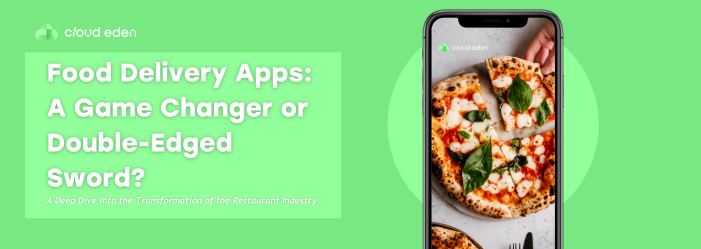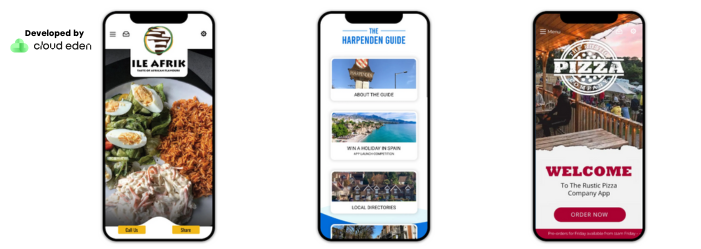Food Delivery Apps: A Game Changer or Double-Edged Sword?
A Deep Dive into the Transformation of the Restaurant Industry

The rise of food delivery apps has undeniably revolutionized the way we consume food. Gone are the days of flipping through phone books or relying on local knowledge to find a good meal.
Today, with a few taps on our smartphones, a world of culinary options arrives at our doorstep – a convenience that has fundamentally altered the landscape of the restaurant industry.
Let's take a deeper look at things
- A Boon for Convenience and Customer Reach
- Unmatched Choice
- Effortless Ordering
- Real-time Tracking
- The Financial Impact: A Double-Edged Sword
- Commission Fees
- Marketing Costs
- Loss of Customer Relationship
- Operational Challenges and Considerations
- Maintaining Food Quality
- Kitchen Efficiency
- Delivery Driver Reliance
- Strategies for Success in the Delivery App Era
- Menu Optimization
- Packaging Investments
- Delivery-Only Menu Items
- Partnering with the Right App
- Leveraging Technology
- Building Brand Identity
- The Future of Food Delivery: Collaboration is Key
- Direct-to-Consumer Delivery
- Subscription Models
- Data-Driven Optimization
- Focus on Sustainability
- The Evolving Role of Restaurants and Delivery Apps
- Restaurants as Experience Providers
- Delivery Apps as Curators
- Conclusion: A Symbiotic Relationship
- Beyond the Basics: Exploring Additional Considerations
- The Rise of Ghost Kitchens
- The Impact on Labor
- Regulatory Landscape
But is this change a positive one? Are food delivery apps a game changer for restaurants, or a double-edged sword that cuts into their profits?
A Boon for Convenience and Customer Reach:
There's no denying the convenience factor that food delivery apps offer. For customers, they provide:
- Unmatched Choice: Gone are the limitations of geographical proximity. Customers can now explore a vast array of cuisines and restaurants, from hidden gems to established favorites, all within a single app.
- Effortless Ordering: The intuitive interfaces of these apps make ordering a breeze. Customers can browse menus, customize their orders, and pay seamlessly, all from the comfort of their couch.
- Real-time Tracking: No more waiting by the window, wondering when the doorbell will ring. Food delivery apps provide real-time tracking of orders, allowing customers to anticipate their arrival.
This convenience translates into a win for restaurants as well. Delivery apps have opened doors to a wider customer base, extending their reach beyond the limitations of their physical location. This is particularly beneficial for:
- New and Niche Restaurants: Previously, it could take months, even years, for a new establishment to build a loyal clientele. Delivery apps provide immediate access to a vast pool of potential customers, allowing them to establish their brand and build a following much faster.
- Restaurants in Underserved Areas: Locations that might not have seen high foot traffic can now leverage delivery apps to reach customers who wouldn't have otherwise discovered them.
- Virtual Restaurants: The concept of a restaurant existing solely online, relying entirely on delivery, has become a viable business model thanks to these apps.
The Financial Impact: A Double-Edged Sword
While the convenience factor is undeniable, the financial impact of food delivery apps for restaurants is more complex. Let's delve deeper:
- Commission Fees: The biggest financial hurdle for restaurants is the commission charged by delivery app companies. These fees can range from 20% to 30% of the order value, significantly impacting a restaurant's profit margin. This forces some restaurants to raise menu prices to compensate, which can deter customers.
- Marketing Costs: To gain visibility within the crowded app landscape, restaurants often have to engage in paid advertising campaigns offered by the delivery platforms. These additional marketing costs further erode profit margins.
- Loss of Customer Relationship: When a customer orders through a delivery app, the direct interaction with the restaurant is lost. This makes it harder for restaurants to build brand loyalty and encourage repeat business.
Operational Challenges and Considerations:
Beyond the financial implications, food delivery apps present operational challenges for restaurants:
- Maintaining Food Quality: Delivery introduces a variable – time - that can negatively impact food quality. Restaurants need to adapt their packaging and menu offerings to ensure dishes arrive fresh and at the optimal temperature.
- Kitchen Efficiency: A sudden influx of delivery orders can overwhelm a restaurant's kitchen, leading to longer wait times and frustrated customers. Restaurants need to optimize their workflow to handle both dine-in and delivery orders efficiently.
- Delivery Driver Reliance: The quality of the delivery experience hinges on the drivers. Late deliveries, mishandled orders, and unprofessional behavior can damage a restaurant's reputation, despite the food being perfect when it left the kitchen.
Strategies for Success in the Delivery App Era
Despite the challenges, restaurants can navigate the food delivery app landscape successfully with the right strategies:
- Menu Optimization: Streamline the menu for delivery, focusing on dishes that travel well and maintain their quality.
- Packaging Investments: Invest in high-quality packaging that keeps food hot or cold, prevents spills, and maintains presentation.
- Delivery-Only Menu Items: Develop specific menu items specifically designed for delivery, which can be priced with commission fees in mind.
- Partnering with the Right App: Not all delivery apps are created equal. Research commission structures, target audience demographics, and marketing reach before partnering with an app.
- Leveraging Technology: Explore integrating kitchen display systems with delivery platforms for improved order accuracy and efficiency.
- Building Brand Identity: While the direct customer interaction is reduced, restaurants can still utilize the app platform to showcase their brand story and personality.
The Future of Food Delivery: Collaboration is Key
The future of food delivery lies in collaboration. Here's where the industry is headed:
- Direct-to-Consumer Delivery: Restaurants with established customer bases may explore building their own delivery infrastructure or partnering with local delivery services to bypass app commission fees and retain control over the customer experience.
- Subscription Models: Subscription-based delivery models, where customers pay a monthly fee for access to exclusive discounts and expedited delivery, could emerge as a way to build customer loyalty and recurring revenue for restaurants.
- Data-Driven Optimization: Delivery apps and restaurants can leverage data analytics to optimize delivery times, predict peak ordering periods, and tailor menus based on customer preferences in specific neighborhoods.
- Focus on Sustainability: Consumers are increasingly concerned about environmental impact. Delivery apps and restaurants will need to find solutions for sustainable packaging and explore eco-friendly delivery options like electric bicycles or designated delivery zones for walking couriers.
The Evolving Role of Restaurants and Delivery Apps:
As the industry evolves, both restaurants and delivery apps will need to adapt their roles:
- Restaurants as Experience Providers: While delivery remains a key component, restaurants may need to focus on creating unique and memorable dine-in experiences to differentiate themselves in a crowded marketplace.
- Delivery Apps as Curators: Delivery apps can evolve from simple ordering platforms to curated marketplaces, offering personalized recommendations and loyalty programs that incentivize repeat business for restaurants on their platform.
Conclusion: A Symbiotic Relationship
Food delivery apps have undeniably transformed the way we consume food. While they present challenges for restaurants, particularly around finances and operations, the convenience and customer reach they offer are undeniable benefits. The future of the industry lies in a symbiotic relationship between restaurants and delivery apps, where collaboration and innovation unlock growth for both sides. By optimizing their offerings, building strong partnerships, and prioritizing sustainability, restaurants can thrive in the age of food delivery apps.
Beyond the Basics: Exploring Additional Considerations
This analysis provides a broad framework for understanding the impact of food delivery apps. To delve deeper, here are some additional considerations:
- The Rise of Ghost Kitchens: Delivery-only kitchens with no dine-in options are becoming increasingly popular. These virtual restaurants leverage delivery apps to reach customers and offer a wider variety of cuisines without the overhead costs of a physical restaurant.
- The Impact on Labor: The rise of delivery apps has created new job opportunities for delivery drivers. However, concerns exist around worker classification and fair compensation for these independent contractors.
- Regulatory Landscape: As the food delivery industry continues to grow, regulations may need to evolve to address issues such as data privacy, driver safety, and competition within the app marketplace.
By staying informed about these evolving trends and complexities, restaurants and consumers alike can navigate the ever-changing world of food delivery apps and reap the benefits of this transformative technology.
Welcome To Our Blog






